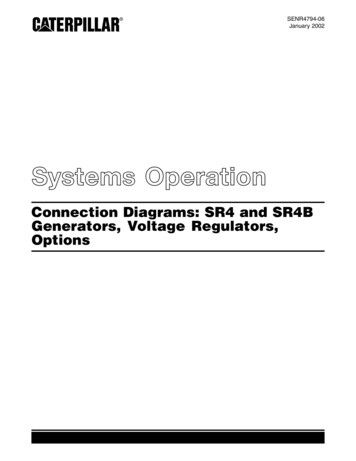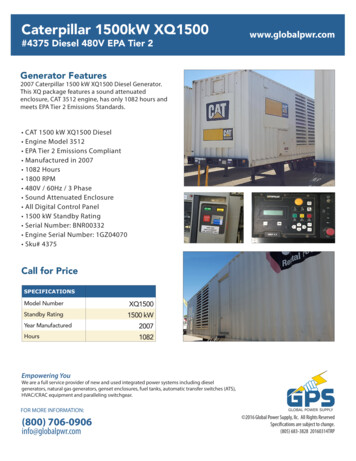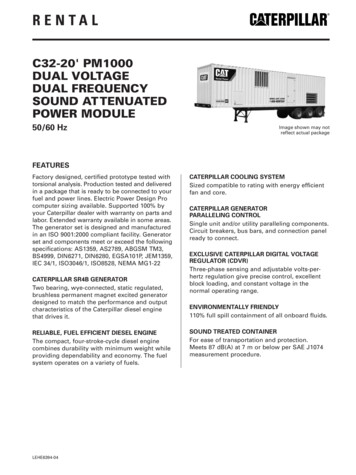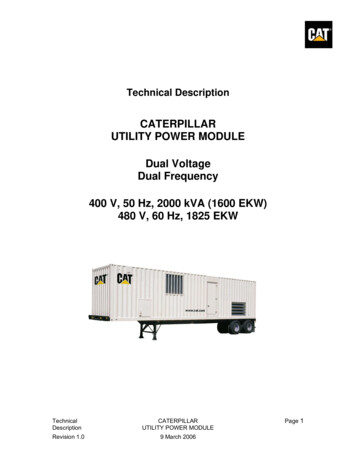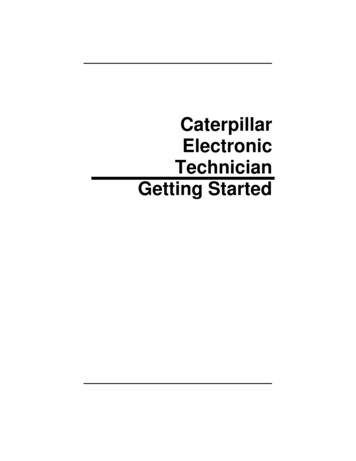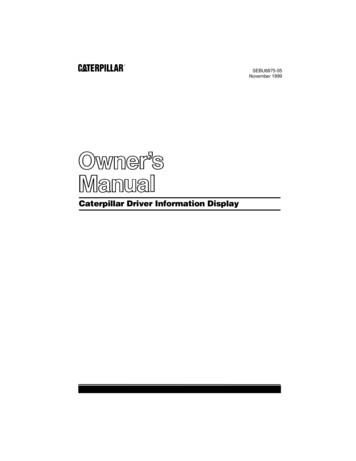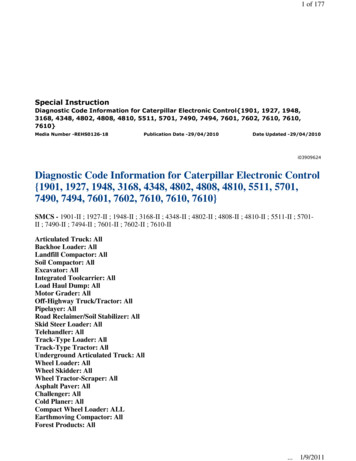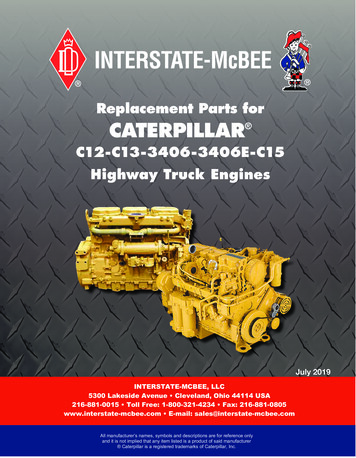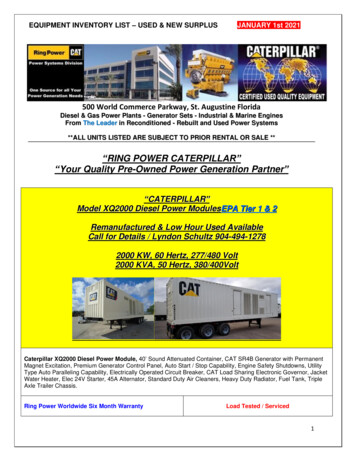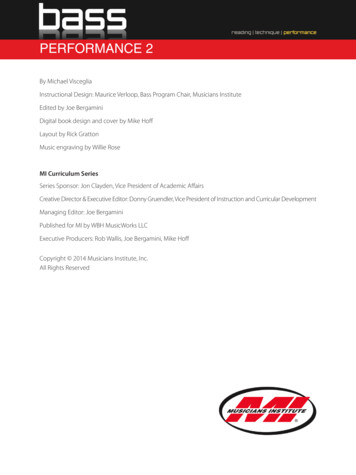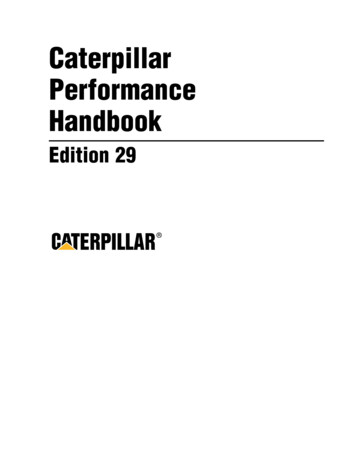
Transcription
CaterpillarPerformanceHandbookEdition 29
CONTENTSPagePreface . . . . . . . . . . . . . . . . . . . . .4Operator andMachine Protection . . . . . . . . .5Replacement Parts Warning . . . .7Nomenclature . . . . . . . . . . . . . . .8TRACK-TYPE TRACTORS1AGRICULTURAL TRACTORS2MOTOR GRADERS3EXCAVATORS4BACKHOE LOADERS5SKIDDERS6PIPELAYERS7WHEEL TRACTOR-SCRAPERS8CONSTRUCTION & MINING TRUCKS/TRACTORS9ARTICULATED TRUCKS10WHEEL TRACTORS SOIL/LANDFILL COMPACTORS11WHEEL LOADERS12TRACK LOADERS13INTEGRATED TOOLCARRIERS14TELESCOPIC HANDLERS15PAVING PRODUCTS16ELPHINSTONE UNDERGROUND MINING MACHINES17HYDROMECHANICAL WORK TOOLS181
ENGINES19FORMER MODELS20OWNING & OPERATING COSTS21TIRES22MINING AND EARTHMOVING23LOGGING AND FOREST PRODUCTS24STOCKPILE COAL HANDLING25LAND CLEARING26WASTE DISPOSAL27TABLES28INDEX293
PREFACEMachine performance must ultimately be measured in unit cost of material moved, a measure thatincludes both production and costs. Factors bearingdirectly on productivity include such things asweight to horsepower ratio, capacity, type of transmission, speeds and operating costs. The Performance Handbook considers these factors in detail.There are other less direct machine performance factors for which no tables, charts or graphs are possible. Serviceability, parts availability and operatorconvenience are examples. In comparing machineperformance, all factors should be considered. ThisHandbook is intended as an aid which, when coupledwith experience and a good knowledge of localconditions, can assist in estimating true machineperformance.Many sections of the Handbook include tables orcurves showing cycle times or hourly production figures for Caterpillar machines under certain conditions. Statements of conditions always accompanyor precede the curves or tables. Before using any performance information in this Handbook, a completeunderstanding of the qualifying conditions is essential.The data is based on field testing, computer analysis, laboratory research and experience; and everyeffort has been made to assure their correctness.However, all such data is based upon 100% efficiency in operation — a status which cannot beachieved continuously even under ideal conditions.Thus, in using such performance and productiondata, it is necessary to correct the results indicatedin the handbook tables by appropriate factors. Thisallows for the anticipated actual job efficiency, operator efficiency, material characteristics, haul roadconditions, altitude and other factors which mayreduce performance or production on a particular job.4Methods for estimating machine owning and operating costs vary widely, depending on locality, industry practices, owner preferences and other factors.One method is suggested in the Handbook sectionon Owning and Operating Costs. When used withgood judgment, it has provided reasonably accurateestimates in the past. Included in the Owning andOperating Section are guidelines, based on workingconditions, to assist in estimating consumption offuel and lubricants, tire life and repair costs forCaterpillar machines. However, what one Handbookuser regards as “excellent” conditions, another mayconsider “severe” or “average”, depending on his ownexperience and basis of comparison. Therefore, theseguidelines should be considered only approximations.Caterpillar Inc. has made every effort to assurethat the information contained in this Handbook isaccurate and is a fair statement of the results to beachieved in the circumstances indicated. However,because of the many variables involved in estimating the production or performance of earthmovingmachinery, their consumption of fuel and lubricants,tire life and repair costs, and the possibility of inadvertent errors or omissions in assembling this data,Caterpillar cannot and does not imply that all datain this book are complete nor that this level of performance will be achieved on a given job.Specifications shown in this Handbook were current at time of printing. However, due to Caterpillar’smany machine improvement programs, specifications and materials may change without notice. Forcurrent specifications relating to a machine’s performance, please refer to the most recent Caterpillarproduct specification sheet.Caterpillar Inc.
OPERATOR ANDMACHINE PROTECTIONA well trained operator, working under suitableconditions, utilizing a modern, properly-equippedmachine provides a machine-operator team capableof giving maximum production. These factors, alongwith appropriate job site rules and communicationprocedures, are essential to coordinate people andmachines working together. Appropriately protectedand maintained machines are less likely to sufferpremature component failure or damage, and giveoperators the confidence and assurance they needto carry out their work. Furthermore, training isnot complete until the operator reads, understandsand agrees to follow the instructions provided in theOperation and Maintenance Manual included withevery Caterpillar machine.Employers have a duty to provide a safe work placefor their employees. The purchaser of a Caterpillarmachine has a duty to review his/her particular application and job site for the machine to identify potential hazards inherent to that application or job site.Based on the results of this hazard analysis, theappropriate operator and machine protection configuration can be determined.Caterpillar designs, builds, and tests its productsto ensure the safety of operators, maintenance persons, service persons, and bystanders. Caterpillar provides as standard equipment the appropriate operatorand machine protection for most applications. However, particular applications may require additionaloperator and/or machine protection. Caterpillar offersrelated options for most such applications. However,there may be very special applications where theCaterpillar Dealer or the Purchaser may want to fabricate, or request Caterpillar to provide, custom orspecial guarding. Your Caterpillar Dealer can helpyou with this hazard analysis and guarding configuration process.I. Operator Training and Protection PracticesRemember that any kind of machine or mechanicaldevice can be hazardous if not kept in good condition, or if operated by careless or improperly trainedoperators, or if operated in an irresponsible manner.Listed below are some recommended basic stepsthat can be broadly applied to most work environments: Train operators for the job they are assigned todo. The length and type of training must complywith governmental and local regulations whereverthey apply. As an example, machine operators inmining activities must be trained in accordance withMine Safety and Health Administration (MSHA)regulations. Where specific regulations do not apply,no operator should be assigned to a job until he orshe meets the following minimum requirements:– Completes proper training to operate the assignedmachine and understands that seat belts must beworn whenever seated in operator’s compartment.– Reads and understands the Operation & Maintenance manual for that machine, and knowsthat a copy of that manual is stored in the operator’s compartment.– Reads and understands the EMI (EquipmentManufacturer’s Institute), CIMA (ConstructionIndustry Manufacturers Association), or anyother furnished manual related to rules for safemachine operation and identification of hazards.– Has appropriate personal safety equipment andknows how to use it. This includes such thingsas hard hat, gloves, safety glasses, hearing protection and safety shoes.– Knows what the job requirements are, whatother machines are working in the area, and isaware of any hazardous conditions that mayarise. Be sure operators are alert and in proper physical and mental condition to perform their workassignments safely. No machine should be operated by a person who is drowsy, under the affectof medicines or drugs, suffers blackouts, or is suffering from any physical or mental distractionthat could contribute to unsafe operation.5
Maintain proper job conditions and working procedures. Check the job for possible hazards, bothabove and below ground level. Look for all possible sources of danger to the operator and othersin the area. Pay particular attention to conditionswhich may be hazardous or near the operatinglimits of the machine: e.g., side slopes, steep grades,potential overloads, etc. Examine the work site forrestricted traffic patterns, obstructed views, congestion, etc. Hazardous work conditions shouldbe corrected wherever possible and adequate warnings should be posted when applicable. Provide the correct machine to handle the job andequip it properly for the job to provide the necessary operator protection. Check for compliancewith all applicable governmental and local regulations. It is the machine owner’s or employer’slegal responsibility to see that his equipment complies with, and is operated in accordance with, allsuch requirements. Make sure the machine is properly maintained.A walk-around inspection should be performed atthe beginning of each shift before the machine isplaced in operation. If this inspection reveals anyproblems that could affect safety, the machinemust not be operated until these problems are corrected. Some examples include:– Loose, bent or missing grab irons, railings orsteps;– Worn, cut or missing seat belts (any seat beltover three (3) years old must be replaced regardless of condition);– Damaged windows in the operator’s compartment;– Worn, rubbing or abraded electrical insulationand hoses;– Any fluid leaks; and– Missing or damaged guards.It is the machine owner’s or employer’s responsibility to ensure the machine is properly maintained.Your Caterpillar Dealer will be glad to assist youin selecting and equipping the machine best suitedfor your job and in providing maintenance for yourmachines.II. Machine ModificationsModifications must not be made to the machinethat:– Interfere with operator visibility;– Interfere with ingress, egress from the machine;– Exceed the rated payload or gross combinationweight of the machine resulting in overloadingthe braking and/or steering system or the rollover protective structure (ROPS) capacity rating (shown on a plate affixed to the ROPS); or– Place objects in the cab that intrude into the operator’s space or that are not firmly fixed into place.6III. Operator-related Equipment OptionsEach job presents unique conditions that must betaken into account. Consider direct dangers to theoperator as well as all possible sources of distraction that could reduce operator efficiency and increasethe chances of costly and dangerous mistakes. Climatecontrolled, sound-suppressed cabs, and special exterior lighting are options available from Caterpillarthat can address requirements of special workingenvironments.“Flexible” machines include hydraulic excavators(track-type, wheel-type, and compact), skid-steerloaders, backhoe loaders and integrated tool-carriers. Work tools or any tool used in hazardous applications like demolition and logging, can create a needfor special operator guarding. When flying debrisfrom impact, cutting, shearing or sweeping attachments is present, additional protective devices suchas a front screen, Falling Object Guarding System(FOGS, includes top & front guarding), thick polycarbonate windshields or a combination of these isrecommended by Caterpillar. Contact your CaterpillarDealer for operator guarding options on your machine.IV. Machine ProtectionCheck the job for unusually demanding conditionsthat could cause premature failure or excessivewear of machine components. Additional protectivedevices such as heavy-duty radiator guards, crankcaseguards, engine enclosures, track roller guards and/orbrake shields may be needed. Also, consider the useof anti-vandalism devices, such as cap locks and instrument panel guards. Contact your Caterpillar dealerfor machine-protection and vandalism-preventionoptions for your machine.V. Fire PreventionRemember that most fluids on your machine areflammable!To minimize the risk of fire, Caterpillar recommends following these basic steps:– Remove trash (leaves, twigs, papers, etc.) thatmay accumulate in the engine compartment.– Do not operate a machine if leakage of flammable fluids is noticed. Repair leaks beforeresuming machine operation. Most fluids usedin Caterpillar machines should be consideredflammable.– Keep access doors to major machine compartments in working order to permit the use of firefighting equipment, should a fire occur.– Avoid attaching electrical wiring to hoses andtubes that contain flammable or combustiblefluids.
– Replace any rubbing, damaged, frayed, kinkedor leaking hydraulic hoses or fittings.– Follow safe fueling practices as described inCaterpillar Operation & Maintenance Manuals,EMI or CIMA Safety Manuals, and local regulations.As an additional safety measure, keep a 10-pound(4.5 kg) minimum fire extinguisher on the machinein a location as specified in the Operator and Maintenance Manual.VI. Safety RegulationsRegulations vary from country to country andoften within country. Your Caterpillar dealer canassist you in properly equipping your machine tomeet applicable requirements. Note: The generalsummaries given below are not substitutes forreading and being familiar with the appropriate local laws.(a) United States (US)With a few exceptions, all machine operations inthe United States are covered by federal and/or stateregulations. If the machine is used in mining activities, the regulations are administered by the MineSafety and Health Administration (MSHA). Otheractivities, including construction, are under regulations administered by the Occupational Safetyand Health Administration (OSHA). These agenciesrequire employers to provide a safe working environment for employees. Caterpillar has the sameobjective.OSHA and MSHA have adopted criteria for ROPS,Falling Object Protective Structures (FOPS), seatbelts, warning horns, back-up alarms,
Specifications shown in this Handbook were cur-rent at time of printing. However, due to Caterpillar’s many machine improvement programs, specifica-tions and materials may change without notice. For current specifications relating to a machine’s per-formance, please refer to the most recent Caterpillar product specification sheet. Caterpillar Inc. 4

